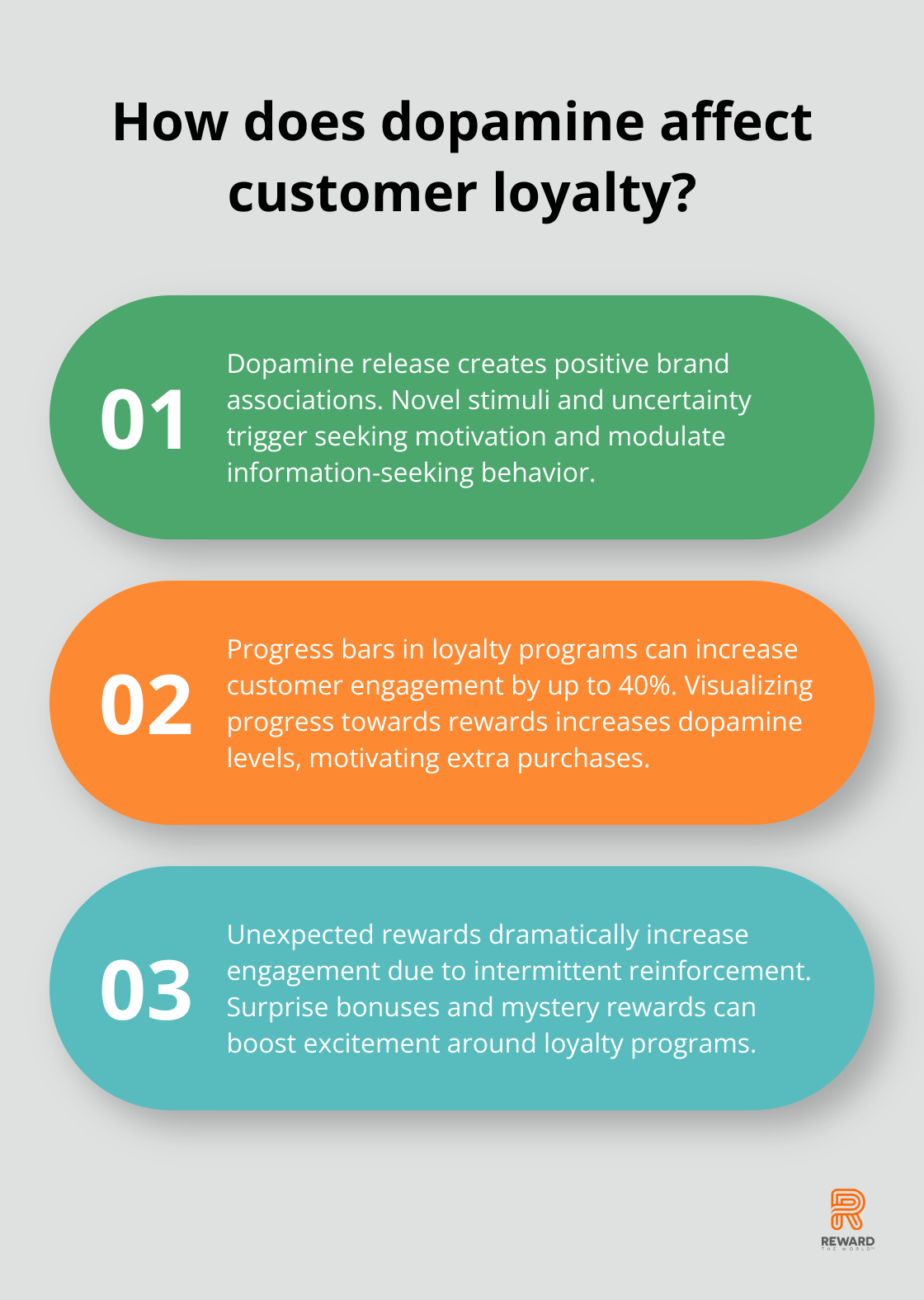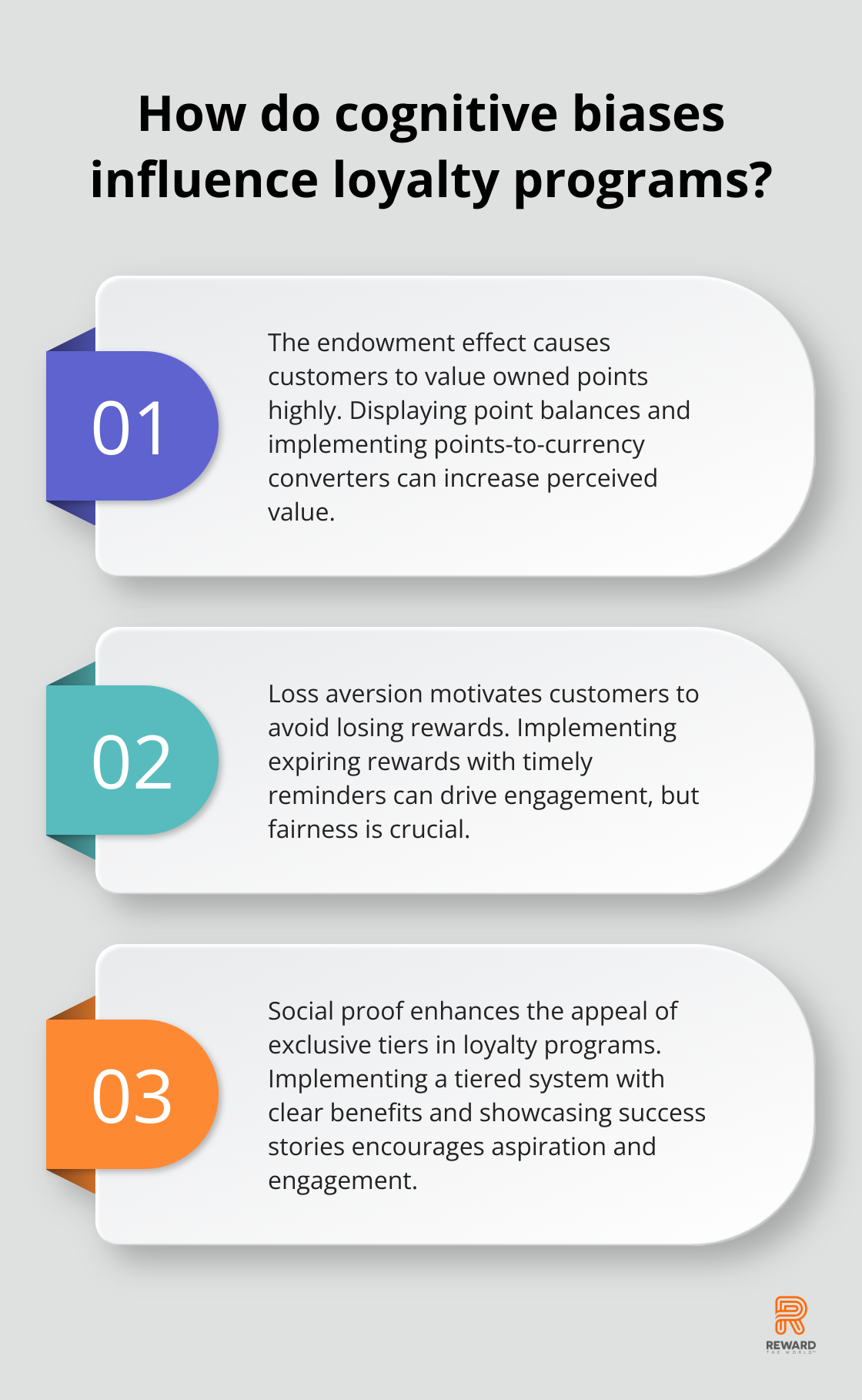
At Reward the World, we’re fascinated by the intersection of neuroscience and customer loyalty. Brain science offers powerful insights into what makes rewards truly irresistible.
In this post, we’ll explore how neuromarketing insights can revolutionize loyalty program design. We’ll uncover the psychological triggers that keep customers coming back and show you how to apply these principles ethically and effectively.
The Psychology of Rewards and Motivation
The Dopamine Effect
Novel stimuli and uncertainty trigger seeking motivation and modulate information-seeking behavior. When customers receive a reward or anticipate one, their brains release dopamine, creating a positive association with your brand. This neurochemical response explains why loyalty programs can be so effective.

To harness this effect, implement a progress bar in your loyalty program. As customers see themselves approaching a reward, their dopamine levels increase, motivating them to make that extra purchase. A study by the Journal of Consumer Research found that visualizing progress can increase customer engagement by up to 40%.
Unexpected Delights
While consistent rewards matter, the real magic happens with intermittent reinforcement. Unpredictable rewards dramatically increase engagement. This approach, inspired by the psychology of gambling, suggests that unpredictable rewards excite and motivate more than those given on a fixed schedule.
Add surprise bonuses or limited-time offers to your loyalty program. You could send customers a “mystery reward” on their birthday or after reaching a certain milestone. These unexpected perks can boost engagement and create excitement around your program.
The Power of Anticipation
Anticipation motivates powerfully. The mere expectation of a reward can stimulate as much as the reward itself. This explains why teaser campaigns and countdown timers work so well in marketing.
In your loyalty program, build anticipation by announcing upcoming rewards or exclusive events in advance. You could also introduce a “reward of the month” feature, where members look forward to a special offer each month.
Leveraging Scarcity
The principle of scarcity can stimulate customer loyalty by increasing the perceived value and urgency of the offer. Limited-time offers or exclusive rewards for a select group of customers can create a sense of urgency and increase participation.
Try offering “flash sales” exclusive to loyalty program members or create tiered rewards where higher tiers have access to more exclusive perks. This strategy not only encourages immediate action but also motivates customers to strive for higher loyalty tiers.
The Social Aspect
Humans are inherently social creatures, and this trait extends to our consumer behavior. Incorporating social elements into your loyalty program can boost engagement and create a sense of community among your customers.
Consider adding features like referral bonuses, where members earn rewards for bringing in new customers, or create challenges that members can complete together. You could also showcase top members or allow customers to share their rewards on social media, tapping into the power of social proof.
As we move forward, let’s explore how cognitive biases can be leveraged to create even more compelling loyalty programs. Understanding these inherent mental shortcuts can help you design a program that truly resonates with your customers’ subconscious decision-making processes.
How Cognitive Biases Shape Loyalty Programs
Cognitive biases significantly influence customer behavior within loyalty programs. Understanding and leveraging these inherent mental shortcuts allows us to create more compelling and effective loyalty initiatives. Let’s explore how three key biases can enhance your loyalty program’s appeal and effectiveness.
The Endowment Effect: Points as Valuable Assets
The endowment effect is a psychological quirk where people place higher value on things simply because they own them. In loyalty programs, this translates to customers feeling a strong sense of ownership over their accumulated points or rewards.

To leverage this bias, display point balances prominently to customers.
Implement a points-to-currency converter, showing customers the monetary value of their points. This tangible representation can increase perceived value and motivate further engagement.
Loss Aversion: The Impact of Expiring Rewards
Loss aversion stands as one of the most potent principles in behavioral economics. People typically show more motivation to avoid losses than to acquire equivalent gains. This bias can powerfully motivate loyalty program participants when used ethically.
Implement a system of expiring rewards or points, but ensure it’s fair and well-communicated.
Send timely reminders about upcoming expirations. (However, always provide ample time and opportunities for customers to use their rewards to maintain positive relationships.)
Social Proof: The Appeal of Exclusive Tiers
Social proof, the idea that people look to others to guide their behavior, can significantly impact loyalty programs. Exclusive tiers tap into this bias by creating a sense of status and community.
Implement a tiered system with clear benefits for each level. Tiered loyalty programmes segment customers into distinct tiers based on their engagement & spending habits. Make the benefits of higher tiers visible to all members to encourage aspiration.
Showcase success stories or testimonials from members who have reached higher tiers. This not only provides social proof but also helps members envision their own progress.
These cognitive biases offer powerful tools for shaping loyalty programs. The next section will explore how neuroscience-based strategies can further enhance your program design, creating even more engaging and effective loyalty initiatives.
How Neuroscience Enhances Loyalty Programs
Personalization: The Key to Relevance
The brain’s self-relevance effect shows that people pay more attention to information that relates directly to them. A text mining analysis of 469 articles has provided insights into this phenomenon and its implications for consumer behavior.

Data analytics tailors rewards to individual preferences. For example, if a customer frequently purchases eco-friendly products, offer them rewards from sustainable brands. This level of personalization increases engagement and strengthens the emotional connection between the customer and your brand.
A preference center allows customers to explicitly state their interests. This direct input, combined with behavioral data, allows for hyper-personalized reward offerings that feel uniquely relevant to each member.
Gamification: Triggering Flow States
Gamification elements in loyalty programs can affect consumers’ reward redemption patterns and purchase behavior. Research has shown that the shift from traditional loyalty cards to mobile-driven loyalty apps has significant impacts on customer engagement.
Challenges or missions within your loyalty program work well. For instance, create a “30-day fitness challenge” for a sports retailer, where members earn extra points for logging workouts. This approach increases engagement and aligns with the brand’s values and products.
Progress bars, levels, and badges visualize advancement. The challenges should be achievable but still require effort, striking the perfect balance to maintain interest without causing frustration.
Storytelling: Creating Emotional Connections
The human brain responds to stories. Neuroscience research shows that narratives activate multiple areas of the brain, creating stronger, more lasting memories and emotional connections.
A compelling narrative around your loyalty program works wonders. Instead of simply offering points, create a story that members are part of. For example, a travel rewards program could frame points accumulation as “building your dream vacation.” This narrative approach makes the process of earning rewards more engaging and emotionally resonant.
Success stories of members who’ve achieved significant rewards (or how rewards have positively impacted their lives) provide social proof and help other members envision their own success within the program.
Reward Anticipation: Leveraging Dopamine
The anticipation of rewards triggers dopamine release in the brain, creating a sense of excitement and motivation. This neurochemical response explains why loyalty programs can be so effective.
Try to implement a progress bar in your loyalty program. As customers see themselves approaching a reward, their dopamine levels increase, motivating them to make that extra purchase.
Teaser campaigns and countdown timers work well in marketing because they build anticipation. Announce upcoming rewards or exclusive events in advance. You could also introduce a “reward of the month” feature, where members look forward to a special offer each month.
Intermittent Reinforcement: The Power of Surprise
Intermittent reinforcement can impact consumer behavior and loyalty. Recent research has reviewed literature on consumer behavior and its impact on consumer loyalty, highlighting key determinants such as brand loyalty and loyalty programs.
Add surprise bonuses or limited-time offers to your loyalty program. You could send customers a “mystery reward” on their birthday or after reaching a certain milestone. These unexpected perks boost engagement and create excitement around your program.
Final Thoughts
Brain science provides powerful insights for creating irresistible loyalty programs. Understanding the dopamine reward system, cognitive biases, and neuroscience-based strategies allows businesses to design programs that resonate with customers on a deep, psychological level. The principles we discussed stem from our understanding of how the human brain processes rewards and motivation.

Neuromarketing insights enable the creation of loyalty programs that drive engagement and foster genuine emotional connections with customers. However, it’s important to apply these tools ethically, aiming to create mutually beneficial relationships where customers feel valued. The future of loyalty programs looks promising, with advancements in AI and machine learning enabling more sophisticated personalization.
At Reward the World, we strive to stay at the forefront of these developments. Our platform offers businesses a powerful tool for fostering customer loyalty, increasing sales conversions, and enhancing employee recognition (with instant reward delivery spanning various categories). We help businesses create loyalty programs that truly resonate with their customers’ brains and hearts.
